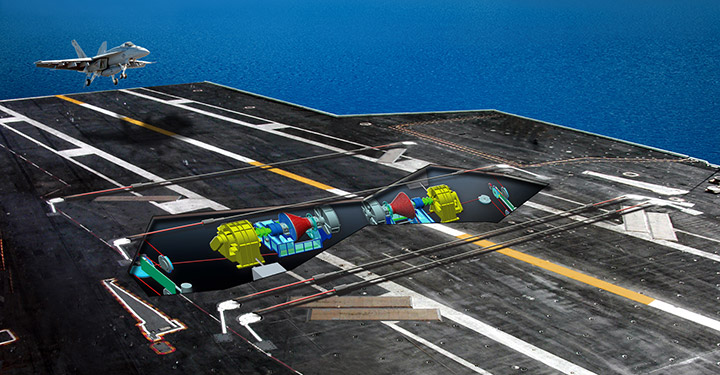
This post has been updated to include a more complete explanation of the design flaw the Navy discovered in the AAG.
The Navy is electing to use the controversial Advanced Arresting Gear on its next Gerald R. Ford-class carrier, John F. Kennedy (CVN-79), USNI News has learned.
Earlier this month, the Navy’s chief weapons buyer notified Congress it was set to install the General Atomics-built AAG on JFK following an evaluation between the AAG and the legacy Mk-7 MOD3 hydraulic arresting system found on the Nimitz-class carriers.
In the last half of 2016, the future of the AAG on carriers beyond Gerald R. Ford (CVN-78) was in doubt and drew scrutiny from the Senate Armed Services Committee and the Office of the Secretary of Defense as part of a larger look of the Ford program.
For its part, the Navy stood up a review board to evaluate use of the system past Ford.
The board – which included Chief of Naval Operations Adm. John Richardson and the Navy’s head of research – reported back to the House and Senate defense committees that reverting to the Mk-7 arresting gear would be cost-prohibitive and result in disruption to construction of future carriers.
In 2015, Naval Sea Systems Command said a design flaw in the AAG’s water twister — a complex paddle wheel that is designed to absorb 70 percent of the force of an airplane’s tailhook landing against an arresting wire, which brings the airplane to a stop — was a complex paddlewheel designed to absorb 70 percent of the force of a landing – was under engineered and would be unable to withstand prolonged use without failing.
In November, the head of NAVSEA commander Vice Adm. Tom Moore, said the testing program for the AAG had shown marked improvements.
“When that ship delivers we’ll be ready to land aircraft on AAG. I think (CVN) 78 is doing much better, and I think we’ll have a fully functional system,” Moore said.
“I don’t want to presuppose any decision, but I believe if the system functions the way it does on 78 — and given where we are on CVN-79 and the construction of the ship — that it’s a very strong and viable path forward for us.”
Still, testing for the system on the ground — slated to be completed two years earlier — had to occur even as Ford was wrapping up pre-delivery testing. The failures in AAG development — in part — was responsible for several delays in delivery of Ford.
In a Monday statement, NAVAIR lauded progress of the program.
“AAG works,” said Capt. Steve Tedford, Aircraft Launch and Recovery Equipment (PMA 251) program manager, whose team manages the recovery system program said in a statement.
“The progress of AAG testing this past year has been significant and has demonstrated the system’s ability to meet Navy requirements. The team overcame many challenges to get the system to this point and ensure its readiness to support CVN 78 and future Ford-class ships.”
In a report the Senate Armed Services Committee released with its Fiscal Year 2017 defense authorization bill, the SASC laid out a pattern of cost increases from about a $476 million in costs for research development and acquisition in 2009 for four systems to a 2016 cost estimate of $1.4 billion – about a 130 percent increase when adjusted for inflation.





